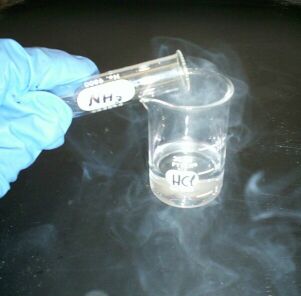Acid
As the properties of an acid are duie to the presence of hydrogen ions H+(aq), Arrhenius defined an acid as follows, 'An acid is a substance that produces hydrogen ions, H+(aq), in water.
Some examples: Ethanoic Acid, Citric Acid, Tartaric acid.
Three common acids used in the school library are hydrochloric acid, sulfuric acid and nitric acid.
Some examples: Ethanoic Acid, Citric Acid, Tartaric acid.
Three common acids used in the school library are hydrochloric acid, sulfuric acid and nitric acid.
Properties:
-Acids have a sour taste
-Acids are hazardous
-Acids change the colour of indicators.
-Acids have a sour taste
-Acids are hazardous
-Acids change the colour of indicators.
Acids react with:
-Metals
-Carbonates and hydrogencarbonates
-Metal oxides and hydroxides
Uses of Acids:
Acids are used to make many products. Sulfric acid are produced all the time for the use to manufacture agricultural fertilisers. Suflic is also used in the manufacture of detergents, paints, dyes, artifical fibres and plastics. Dilut sulfuric acid is used in batteries for road vehicles such as cares and buses. Rust removal is another important use of acids. Rust consists of iron (II) oxide. Rust must be removed from iron and steel objects before painting and coating with other metals. Some acids are also used to preserve foods.
Bases and Alkalis
-Metals
-Carbonates and hydrogencarbonates
-Metal oxides and hydroxides
Uses of Acids:
Acids are used to make many products. Sulfric acid are produced all the time for the use to manufacture agricultural fertilisers. Suflic is also used in the manufacture of detergents, paints, dyes, artifical fibres and plastics. Dilut sulfuric acid is used in batteries for road vehicles such as cares and buses. Rust removal is another important use of acids. Rust consists of iron (II) oxide. Rust must be removed from iron and steel objects before painting and coating with other metals. Some acids are also used to preserve foods.
Bases and Alkalis

Bases - Oxides or hydroxides of metals
(Note! All alkalis are bases, but not all bases are alkalis)
Some examples: copper (II) oxide, sodium hydroxide
Three common alkalis found in the school library are sodim hydroxide, aqueous ammonia and calcium hydroxide
Properties:
-Alkalis are slippery
-Alkalis are hazardous
-Alkalis change the colour of indicators
Alkalis react with:
-Acids
-Ammonium compounds
-Metal ions
Uses of Alkalis:
Alkalis are common in our daily lives. For examples, they are found in cleaners, detergents, toothpastes and soaps. Alksalis are common for two reasons. One is to neutralise acids like how toothpastes neutralise acids on our teeth while the other is to dissolve grease like how soaps and detergents do.
Indicators
pH:
pH values depend on the concentration of acid/base and degree of dissociation. The use of pH in measuring the strength of an acid is limited since it's value changes with concentration.
There are 3 different indicators:
- Litmus paper
- Phenolphthalein
- Universal Indicator
(Note! All alkalis are bases, but not all bases are alkalis)
Some examples: copper (II) oxide, sodium hydroxide
Three common alkalis found in the school library are sodim hydroxide, aqueous ammonia and calcium hydroxide
Properties:
-Alkalis are slippery
-Alkalis are hazardous
-Alkalis change the colour of indicators
Alkalis react with:
-Acids
-Ammonium compounds
-Metal ions
Uses of Alkalis:
Alkalis are common in our daily lives. For examples, they are found in cleaners, detergents, toothpastes and soaps. Alksalis are common for two reasons. One is to neutralise acids like how toothpastes neutralise acids on our teeth while the other is to dissolve grease like how soaps and detergents do.
Indicators
pH:
pH values depend on the concentration of acid/base and degree of dissociation. The use of pH in measuring the strength of an acid is limited since it's value changes with concentration.
There are 3 different indicators:
- Litmus paper
- Phenolphthalein
- Universal Indicator

More than 300 different organizations from at least 40 countries worldwide have used Alfa Chemistry's products and services since its inception. Direct Black GB
ReplyDelete